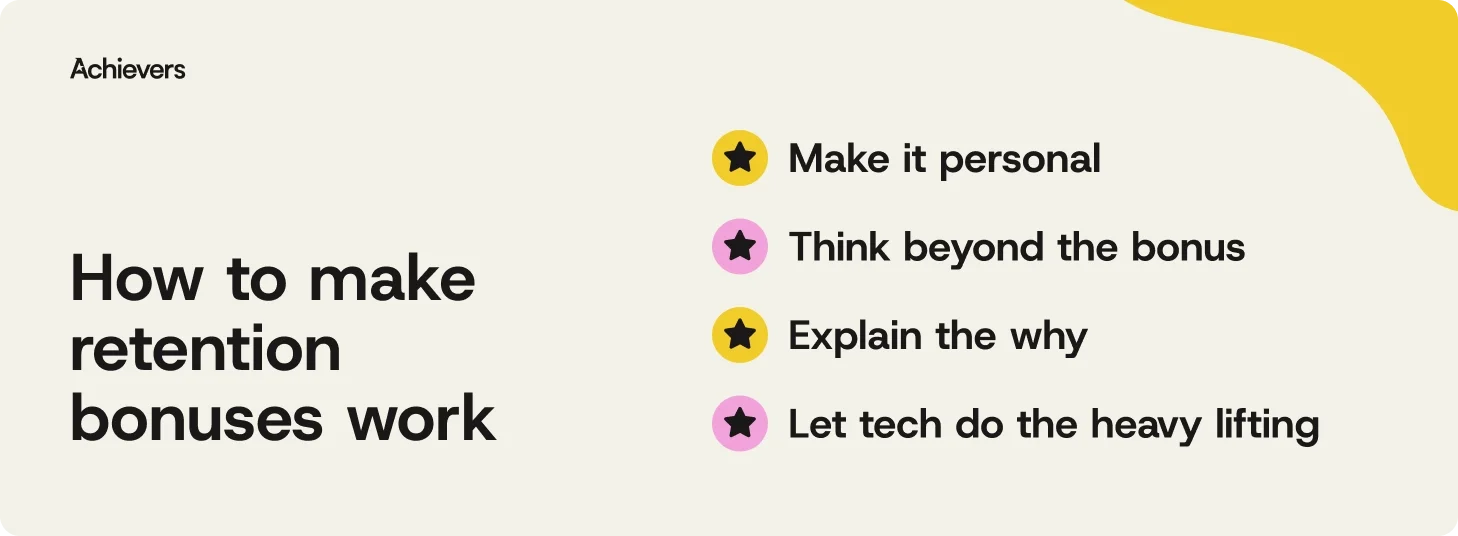Table of contents
Let’s talk turnover. When someone walks out the door, they don’t just take their talents — they take a serious chunk of your budget, too. Entry-level attrition can cost up to 50% of that role’s salary. For mid-level? Try 125%. And if you lose someone highly specialized? Buckle up — it could hit 400%.
It’s not just a financial headache. High attrition hits morale, disrupts momentum, and makes it that much harder to build a culture where people thrive.
Enter: the retention bonus. A quick fix with a tempting price tag. But here’s the thing — staying power doesn’t come from money alone. If you want long-term loyalty, it has to feel personal. And that’s where a thoughtful recognition and rewards strategy comes in.
In this blog, we’ll explore how combining retention bonuses with meaningful, frequent recognition can help shape a more engaged, committed workforce — one that sticks around for the right reasons.
Why retention bonuses shouldn’t fly solo
On paper, retention bonuses seem like a smart move — offer people extra cash to stay, and voilà, problem solved. But in reality? It’s more like a temporary patch than a long-term fix. Used alone, these bonuses rarely address the deeper reasons employees leave: lack of recognition, limited growth, and culture disconnects. To truly move the needle on loyalty and engagement, financial incentives need to be paired with a people-first strategy that makes employees want to stay — not just stick around until payday.
While retention bonuses can be part of the solution, relying on them alone comes with strings attached. Let’s look at why they often fall short — and how to build something that lasts:
Short-term stickiness
A retention bonus might keep someone in their seat through a merger, a crunch project, or a leadership shakeup — and in the short term, that’s a win. But once the bonus hits their bank account, the clock starts ticking. Without genuine engagement or a connection to purpose, employees may begin polishing their resumes before the ink dries. If the work environment isn’t motivating on its own, no amount of bonus will turn a short stay into a lasting career. Retention needs more than money — it needs meaning.
When good intentions backfire
Used sparingly and strategically, retention bonuses can be helpful. But lean on them too much, and things can get… awkward. Selective payouts can spark feelings of favoritism, especially if the criteria aren’t crystal clear. And when bonuses become the only recognition employees receive, it sends a subtle message: “We’re only here for the transaction.” That kind of dynamic erodes trust, culture, and morale. Loyalty built on cash alone is fragile — but loyalty built on recognition, opportunity, and connection? That’s what keeps people around long after the bonus is gone.
How to make retention bonuses actually stick
A retention bonus can get someone to stay — but if you want them to stay engaged, it needs backup. When paired with frequent recognition and meaningful rewards, that one-time payout becomes part of a bigger picture: a culture where people feel seen, supported, and motivated to stay for more than just the money.
Here’s how to blend retention bonuses into your recognition and rewards strategy in a way that actually moves the needle:

- Make it personal: Not everyone’s motivated by the same thing — so don’t treat rewards like a one-size-fits-all hoodie. Tailor retention bonuses and rewards to reflect what actually matters to your people, whether that’s gift cards, extra time off, or something entirely different. The more it reflects their values, the more valued they’ll feel.
- Think beyond the bonus: Retention bonuses shouldn’t live on an island. Use your recognition platform to weave them into your overall approach — celebrating milestones, anniversaries, and major wins with personalized shoutouts or points-based rewards. When people see loyalty recognized in multiple ways, it builds trust, not tension.
- Explain the why: Be transparent about what retention bonuses are for, how they’re earned, and how they fit into your bigger rewards story. When employees understand the purpose — and see that it’s part of a culture of recognition — they’re more likely to feel like partners, not pawns.
- Let tech do the heavy lifting: Use your recognition platform (yes, like Achievers) to streamline how bonuses and rewards are managed. Automate the process, measure engagement, and make it easy for employees to redeem rewards in ways that matter to them. When it all works together, engagement doesn’t just rise — it sticks.
The ROI of pairing retention bonuses with recognition
Retention bonuses can keep people from walking out the door. But if you want them to stick around and stay engaged, you’ll need more than a one-time payout. Real retention happens when financial incentives are part of a bigger, people-centric strategy — one built on recognition, trust, and a culture where employees feel like more than a headcount.
Here’s how combining retention bonuses with a recognition and rewards program turns short-term wins into long-term ROI:
Cost-effectiveness: Don’t put all your dollars in one basket
Standalone retention bonuses sound simple: give someone a financial reason to stay, and they will. And yes, they might — for a while. But bonuses on their own can be expensive Band-Aids. Once the money lands, if employees still feel disconnected or unseen, they may start eyeing the exit anyway. And that one-time cost? Gone.
Now, layer that same bonus into a recognition-rich environment — one where employees are regularly acknowledged for their efforts, achievements, and loyalty — and suddenly, you’re not just buying time. You’re building trust. Recognition programs keep appreciation flowing long after the bonus clears, boosting morale, reinforcing company values, and helping every dollar spent go further. Think of it as investing in loyalty, not just leasing it.
Engagement: Turning bonuses into meaningful moments
A retention bonus may say, “We need you to stay.” But recognition says, “We see you — and we value what you do.” Together? That’s a powerful message. When employees feel appreciated, they’re more likely to be engaged, motivated, and invested in the company’s success — not just their next paycheck.
Achievers Workforce Institute (AWI) research shows that recognized employees are more likely to stick around and go above and beyond. Recognition strengthens emotional ties to the company, connects employees to its purpose, and brings culture to life in everyday moments. Whether it’s a shoutout from a peer, points for a job well done, or celebrating a milestone — consistent recognition creates a ripple effect that amplifies the impact of any bonus.
So, while a bonus may get their attention, recognition earns their commitment. And that’s where the real ROI lives — in a workforce that’s not just staying but thriving.
Retention bonuses work harder when recognition leads the way
A well-placed bonus might keep someone from walking out the door — but if you want them to stick around and stay engaged, you’ll need more than a financial handshake. Real loyalty comes from feeling seen, supported, and celebrated along the way.
That’s where Achievers comes in. Our platform enables you to build a culture of everyday appreciation, while simultaneously delivering personalized rewards that actually mean something to your people (because not everyone dreams of logo’d water bottles). Together, we help transform short-term incentives into long-term impact.
Retention bonuses get them to stay. Recognition makes them want to. Ready to turn both into a smarter strategy?



